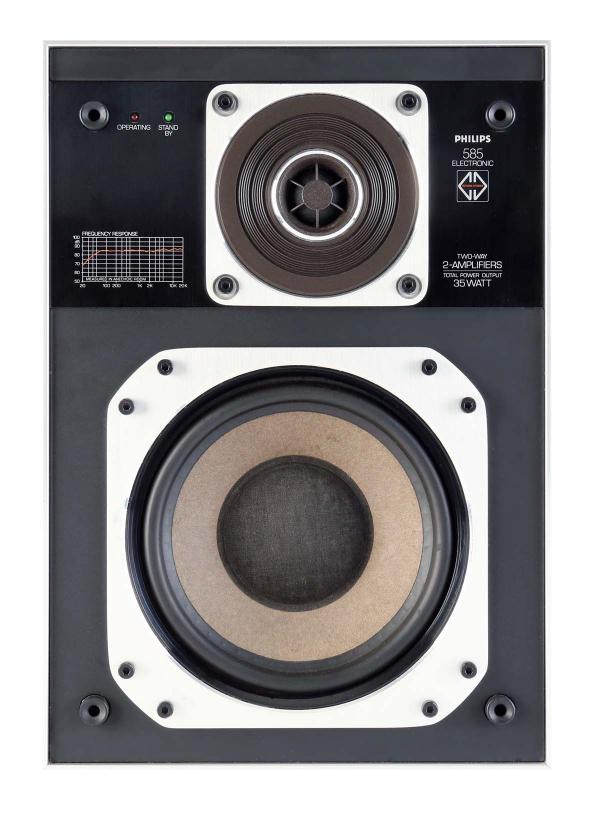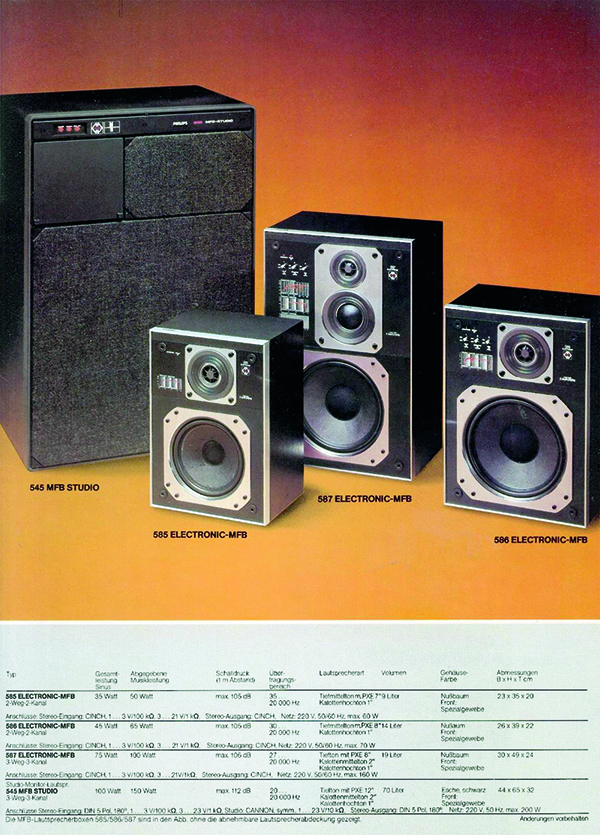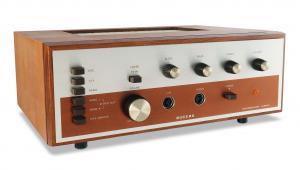Philips AH585 loudspeaker

 Smallest of a four-strong range of innovative MFB (Motional Feedback) loudspeakers, Philips’ AH585 was in production from 1972-82. How does it fare today?
Smallest of a four-strong range of innovative MFB (Motional Feedback) loudspeakers, Philips’ AH585 was in production from 1972-82. How does it fare today?
The Philips Motional Feedback (MFB) loudspeaker has been mentioned a number of times in these pages over recent years. The company achieved considerable success with both its first- and second-generation models, including the 22RH544, but in the UK at least, the third generation is less commonly encountered. The AH585 seen here is the smallest of three consumer speakers, the others being the similar but larger AH586 and the three-way AH587.
These new designs saw Philips work hard to apply its MFB techniques to a series of more conventional-looking speakers. They were also easier to hook up to non-Philips equipment as they used standard RCA connections operating at signal levels and impedances that suited all preamps, rather than just the few made by Philips itself.
Petal To The Metal
The two larger models appeared in 1978 but the AH585 did not arrive until the following year. Previous Philips MFB loudspeakers had been marketed as part of the company’s ‘High Fidelity International’ line but this was beginning to look a little old fashioned as the 1980s approached. To freshen up the offer, the new MFB designs were launched as part of the Black Tulip series and were finished in simulated black ash sporting a bright metal trim to give them a modern, ‘high-tech’ look.
The AH585 was a small two-way model featuring a 180mm MFB woofer and a 25mm soft dome tweeter of a type popular across the industry at the time. Unlike the previous small MFB model (the RH541) it employed two power amplifiers in each enclosure and electronic crossover circuits. The construction of the cabinet was in line with established practices for quality loudspeakers of the period. The outer shell was constructed from 12mm-thick chipboard with the baffle being made as a heavy resin moulding with a deep internal lattice structure to enhance stiffness.
In the original MFB models the electronics had been placed in a sealed-off chamber in the rear of the cabinet, but in the third-generation designs the partition had been removed and replaced with a thick foam rubber block. The rear panel of the amplifier thus formed the back of the loudspeaker pressure chamber and had to be sealed accordingly.
A truly active loudspeaker offers the designer much greater freedom when it comes to the specification of the crossover characteristics. There is no need to worry about efficiency or losses in the components as this is easily corrected with further amplification. Also, filters with much steeper cut-offs and far greater rejection outside the desired band of frequencies can be realised. Phase linear techniques are also easier to employ in active crossovers than in passive ones.

AH585 [front] was the smallest of a range that included the 586, the 587 and the 545 ‘Studio Monitor’, seen here with grilles in place
The design of the crossover circuit in each AH585 unit has a number of features not found in conventional loudspeakers. The first is the use of a global ‘rumble’ type filter that has its corner frequency set at 40Hz and employs a sharp 12dB/octave slope. This effectively defines the lowest frequency the loudspeaker will play down to and prevents the MFB system from having to work too hard. It should not be considered as a serious limitation; conventional loudspeakers of this size begin to show significantly reduced sensitivity at a significantly higher frequency, typically around 100Hz. After this the signal path splits two ways, one going to the woofer and the other to the tweeter.
Meanwhile, the tweeter circuit contains a simple electronic filter that removes all but the treble frequencies, the intriguing part being that this tweeter signal is also electronically subtracted from the signal going into the filter for the woofer. This process performs much of the necessary bass filtering work and ensures that the phase relationship between the two signals is maintained. Nothing like this is possible in a standard passive crossover. After this, MFB correction is applied to the bass signal and in this form it passes to the power amps. This ensures the woofer cone follows the incoming programme signal accurately.


















































